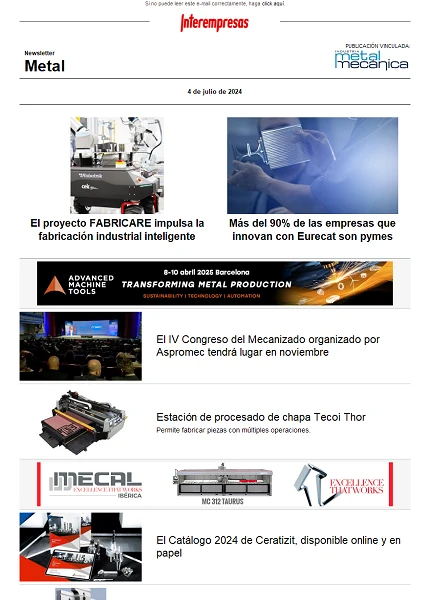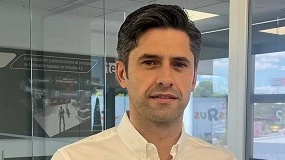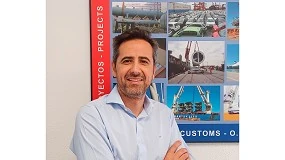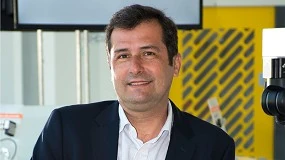Current and prospective industrial polymers
The materials in the K'95
The market of plastics in Europe recovers of the contraction of the past years, to the time that of the storm of prices suffered in summer and autumn of 1995
In the present article offer data on production, demand and development of each one of plastic matters in the next future. The figures have been elaborated by the editorial of Universal plastics from data supplied by Nowea, the committee organiser of the K'95 and several manufacturers of raw materials. The purpose is to provide to the moldeadores a base for his strategic considerations to half term.
The past recession has had an impact in the sector of the upper plastics to the two crises of the oil. Never it had confronted the industry with a situation in that it produced so drastic reduction of the demand and of the use of the installed capacities, with the consequent envilecimiento of the prices.
Like colophon, the practical absence of stocks in the moldeadores and the postponement of the investments in new installations of production combined with the brusque tug of the demand to generate a tempestad of prices that posed new and extreme difficulties to the manufacturers and transformers.
The current impressesion is that this situation, although still colea in some cases, has stabilised already in Europe and is possible to do some minimum predictions of future regarding the behaviour of each material, especially in the geographic area of the European Union. In the lines that follow will find the reader data on each one of the main materials used by the industry of transformation.
Vinílicos
Policloruro of vinyl (PVC): The total capacity installed to ends of 1994 of PVC all over the world was of 25,5 million tonnes (MT), of which corresponded to Western Europe 5,5 MT. The consumption has had a progressive growth in Western Europe in the last ten years, that has happened of the 4 MT of 1986 until the 5,5 MT of 1994 and has been interrupted only by the trienio black of 1991-93.

In 1994 used 93% of the European productive capacity and complemented with equivalent imports to 7% remaining. In spite of the closing of 300.000 T/year of productive capacity two years ago, are setting up new installations and foresees a full recovery of the annual capacity of 1990 (6 MT) for end of century.
Expects also that the world-wide consumption of PVC grow in the order of 4% annual in the next years, although in Europe will be only between 1% and 2%, with an increase tied to the of the construction and to the industry of the wire.
The industry of the car will continue using the material PVC, in spite of the efforts sustitutorios by pressesures of the ecological groups and of the consumers, by his excellent relation performance/cost. The field of pastas for coatings anticorrosivos presents an especially promising future.
The campaigns environingingmentalists against of the PVC does that it was the most investigated material of all the existent. But his basic component, the chlorine (56%), is an available prime matter without limitation and reduces the dependency of the oil and the energetic cost, by what considers that the PVC is one of the most adapted materials for the economies with bearable growth. In sight of this, the conclusion of numerous experts is that if the legislators decide to reduce the use of the PVC would move the problem to other areas.
Will have in brief term of time of installations for the recycled of more than 50% of the waste of material. These installations will be economically profitable when recovering the chlorine, without external energetic contribution, by means of industrial processes at length utlizados in other fields and that they would have to convert to the PVC in leader of percentage of reuse.
Poliolefinas
Polietileno of low density (PE-LD and PE-LLD): produce, to world-wide level, 9,2 MT/year of these olefins, to which the twelve producers of Western Europe contribute with 1,5 MT/year. During the years of recession existed, curiously, a fast increase of capacities that has generated strong tensions to the drop in the market.

Although the PE-LLD will have predictably an annual increase in the order of the 5 % to the 6 % because of his potential like substitutive plastic of engineering, the increase of use of the recycled and the reduction of thicknesses of the packaging will do, according to the experts, that the growth of the PE-LD was inferior to the increase of the activity, expecting annual taxles in the order of 1,5% at most.
Thinks also that the impact of the PE of catálisis metalocénica will not do notice until 1997/98, in spite of the current emphasis in these products by his capacity to adjust his properties to the application proposed, with densities of 0,90, high tenacity and good soldabilidad.
The polietileno is another of the material object of criticism by his impact mediambiental but, due to the fact that his chemical structure is extremely simple, only carbon and hydrogen facilmente recyclable, does him obtain a good ecological balance in front of other competitive materials.
Polietileno Of high density (PE-HD): Similarly to the PE, the set up of additional capacity in 1990 created a considerable excess of offer and only in July of 1994 registered a substantial increase of the demand. The world-wide installed capacity was to finals of 1994 of 19,2 MT tonnes, of which 4,3 MT corresponded to western Europe. The fusion of Neste and Statoil (that it gave like result Borealis) had a greater impact in this market.
The degree of use of the capacity installed now in Europe is in the order of the 85-86%, with 3,8-4 MT/year, expecting arrive to the 91 % the next year. The engine of the growth attributes to the industry of tubes, that is growing around 21%, although it continues being the container injected the main consumer.
Given the annual increase expected of the 4 %, trusts that it arrive prompt to a balance between offer and demand, especially in view of that there is not programmed new installations. The capacity of the PE-HD to offer economic and ecological solutions to a variety of problems does him have good expectations of growth to half term.
Another PE, the one of ultra-high density, is a new material of the that DSM supplies fibres of high tenacity (Dyneema) for reinforcement of composites.
Polipropileno (PP): The increase of the use of the PP did not detain neither in the years of crisis, in that it kept between the 4 and the 7 % to jump to 16% in 1994, with a total capacity of 20,8 MT, of which correspond 5,7 MT to western Europe, that consumed 5,13 MT, being the forecast for 1997 is of 6,1 MT.
As it knows, the homopolymer of PP is quebradizao to low temperatures, by what the greater part of his applications effect by means of copolymers or alloys with elastomers. The growth of the PP between 1988-93 (1,4 MT) has taken place at the expense of the ABS, PS and PVC and, in lower scale, of PA, PE and other materials.
Given his capacity of replacement, this will superimpose to the general economic growth, with what expects an increase of the neighbouring demand to the 6 % annual. For suplirla have realised a series of fusions in addition to the one of Borealis: the union between Shell and Himont in 1995 has given place to the giant Montell, indisputable world-wide leader with 3,5 MT/year, of which 1,5 MT produce in Europe, to the time that Basf purchased the capacities of ICI. Dow, by his part, has announced his plans to establish capacities in the plant of Buna in the ancient RDA, to the time that has done of his installations of Tarragona the centre of European production of poliolefinas metalocénicas.
Estirénicos
Polistireno (PS): The capacities of the greater European producers (by this order, Basf, Atochem, Dow, Enichem and others) add 2,3 MT/year on a world-wide total of 8,2 MT/year, although the consumption in 1994 was of 1,885. Since it does not expect use fully the installed capacity until the year 2000, there are not forecasts of new installations. Curiously, Europe mattered this year 8% of the volume consumed but exported the double, keeping his paper of net exporter.
The PS suffers especially the world-wide shortage of estireno monomer, added to the reduction of prices during the crisis that habáan fallen in 1992 to the exact half of the price of 1989. By añadidura, the irruption of the PP did, to a large extent, at the expense of the PS. However, They are developing new products and one of them, the SPS (polistireno sindiotáctico) possesses qualities that will turn him into a serious competitor of the PPS, PA and PBT for applications of engineering.
Poliestireno Expanded (EPS): The world-wide consumption of EPS was in 1994 of 1,8 MT, of which 36% processes in Europe. In the Old Continent, with a capacity of 820.000 T, the consumption arrived only to 640.000 T. 75% of the production deliver it to him the six first manufacturers, Basf, Shell, Enichem,Hunstmanm, Hüls and BP, to which will join Dow with installations also in Buna.
The reglamentaciones in the construction and in the packaging will favour the use of the EPS, although the forecasts in this regard they are only moderately optimistic. It thinks that the growth will situate between the 2 and the 3 % annual until final of century.

Copolymers of estireno (ABS/ROASTS): The two copolymers, ROASTS and ABS, have alike characteristic and his market, consistently, is parallel. If the ABS applies primordialmente in interiors of the car, ASA has characteristics of resistance to the intemperie that does it apt for outsides. Besides, his favourable behaviour in front of the fogging and good procesabilidad has done to expand the possibilities of the new films of ASA for applications in the interior.
The world-wide installed capacity is of 4,1 MT/year, in which Europe participates with 730.000 T, although the consumption in 1994 has arrived only to 565.000 T. In spite of this, Basf has announced plans of expansion of his capacity in this sector. It foresees a moderate growth to half term, until 650.000 T in the year 2000, with behaviour more dynamic of the ROASTS that of the ABS.
Copolymers of Estireno-Acrilonitrilo (SAINT): The European production of SAINT (67.000 T) is delivered between Basf, Dow, Enichem, Monsanto and Repsol, that sells basically in our country. From 1992 they have closed capacities of 22.000 T and have set up new installations producing 45.000 T/year, although these devote also to the obtaining of SAINT.
Since the primary consumers of products of SAINT are very subject to the economic conditions generals and do not foresee new applications or replacements, calculates for the SAINT an annual growth in the order of the 2 %.

plastic of engineering
Polyamides (PA): The important paper of the polyamides in a big variety of applications had like consequence that only in 1993 there was in Europe a fall of the consumption, that reached the 540.000 T in 1994. The global consumption, by his part, went of 3,8 MT/year, with a first field of application in the fibres.
The first European consumer of moldeados is the industry of the car (145.000 T), followed of the electricity-electronic (120.000 T) and of the packaging (60.000 T).
To the pressesures on the price of the period 1990-94, that motivated that they did not set up new installations, has joined a shortage of fibres of glass that have caused difficulties of supply that still persist. However, the new capacities of fibre that set up will do that it dilute a part of these problems.
Polycarbonate: The world-wide consumption of PC has bent, practically, from 1986 to 1994, in that it reached 845.000 T. Western Europe, with 245.000 T/year, is the second world-wide consumer and has an installed capacity very upper (126 %). The main producers, GE plastics and Bayer (70 % of the European capacity) have developed all a series of co-condensed that open new and promising fields of application to the material, one of the few that did not see affected by the crisis.
One of them is the industry of optics for automotive sector, by means of coatings antirrayado, that has revolutionised this field, and can be even more important the one of glasses for glasses, in that the aligeramiento on the ones of glass, if the forecasts materialise, can provide an important service to a lot of million consumers.
The forecasts for the future of this plastic are of the most optimistic of all the industry; to half term calculates an annual growth in the order of the 8 %, that can extend also to the world-wide consumption.
Polioximetileno (POM): The excellent characteristic technicians of the material and his ease of moldeo have awarded him a very diversified field of technical applications. Thus, his growth has been of the most regular, with an increase in the world-wide capacity of 468.000 to 511.000 T/year in the period 1992-95. In western Europe, Hoechst, Basf and Dupont have a conjoint capacity of 147.000 T/year, for an upper consumption to 131.000 T/year. Dupont plans to expand his capacity in Dordrecht in 35.000 T/year.
An additional favourable factor for the POM is his capacity of recycled quimico without loss of properties by means of escisión of monomers. Thus, the POM can win an additional terrain in the most affected fields by the legislation of the recycled.
Without having this factor in account, the growth of the consumption will situate predictably in 3% annual.
Ether of polifenileno modified (PPE): The introduction in 1966 by GE plastics of his PPO modified for injection Noryl has been one of the histories of success more important of the industry of plastics. Today the installed total capacity is of 322.000 T/year, of which western Europe participates with a 25 %, with GE plastics, Basf, Hüls and Shell like suppliers. By his part, the consumption, that has grown with regularity through the years of crisis, has bent from the 30.000 T of 1980.
Polimetil metacrilato (PMMA): His monomer, the metacrilato of methyl, has a world-wide installed capacity of 1,9 MT, of which the half devote to produce PMMA for articles semiacabados and material of moldeo. The rest of the volume devotes to the production of adhesive, ligantes and coatings and to produce a series of copolymers termoprocesables with estirénicos and elastomers.
The structure of supply has concentrated in the last years, being examples the joint-venture of Elf Atochem and Röhm & Haas (AtoHaas) and of the acquisition by ICI of the business of MMA of Dupont in the U.S. and of Klöckner Pentatec in Germany. This company has announced that will expand in 30.000 T/year his capacity in Rozenburg; AtoHaas increases in 35.000 T/year the ones of Italy and Röhm adds 10.000 T/year to his annual production of cast.
The European producers are TIE-Haas, Basf, Degussa, ICI and Rhöm. After an important fall, the market initiated his recovery in 1994 with 12% of increase, that carried him to the levels of 1990, tendency kept in the first months of 1995, in that even they produced tensions in the supply. It thinks that, after it reach a level of reasonable consumption, the annual growth will reduce to 2,5% to end of century.
Tereftalato Of polietileno (PET): Developed like material for fibres (Tergal, etc.), his main application has been afterwards the manufacture of film for photography, magnetic stravel, reprography and others. The apparition of the process of injection-pulled-blown to half of 1970 determined a second big application of the PET: bottles for carbonaceous beverages, that is at present the most important. Europe, with a consumption of 670.000 T/year, required to matter 13% of these in 1994.
The global production of materials of moldeo enciphers in some 3,5 MT/year, of which 2,5 go to the container and 1 to film pulled. The European producers are Akzo, Bilen, Cobarr,Eastman, Enichem, Hoechst, The Silk, Radici and Shell, some of which produce mainly fibres.
Between 1991 and 1994 the European market grew in a 50 %, of the that the half corresponds to 1994. They expect growths in the order of the 10 % annual until the year 2000.
Tereftalato Of polibutileno (PBT): After a series of years in that his European market declined ostensiblemente, the PBT experienced a strong impulse in 1994, in that they consumed 78.000 T (on 53.000 T in 1993) and covered the installed capacity, estimating a growth in the order of the 8 % in 1995.
Dupont, besides, will complete this year a factory of 30.000 T and a joint-venture of Hoechst and GE plastics another of 60.000 T, both in Germany, bending the European capacity. It treats, therefore, of the polymer in that greater expectations deposit the producers. In addition to the quoted, these are, in Europe, Atochem, Basf, Bayer, DSM, Enichem, Hüls and Rhône Poulenc.
The mixes of PBT head the list of products again development, what is a factor more to foresee a development of the 8 % annual to half term.
Fluoropolímeros: They group under this denomination several types of plastics, whose installed global capacity is of 90.000 T/year. However, it has to take into account that many of those used technologies based in the CFC and are being converted to free processes of this material.

Besides, the perspective varies according to the copolymer; like this, Dupont will have increased in a 75 % his capacity of production for 1997, because of the use of the FEP in the local networks and of the PFA in the industry of semiconductors. Other companies in Asia, United States and the CIS are also mounting new plants.
In Europe, with a capacity of 28.000 T/year, there are five producers: ICI, Hoechst, Ausimont, Elf Atochem and Solvay. Because of the before expressesed reason, the availability of the material in the near future can suffer some shortage until they go in in operation the new installations or reconverted.
plastic of high provision
Sulphide of polifenileno (PPS): This plastic finds in the border between the technicians and the ones of high performance, since when adding him loads and reinforcement of fibres obtains a resistance to the termoformado neighbouring to his melting-point. They exist two types, the reticulado developed by Phillips and the linear obtained by Kureha.

The development of the PPS has been of the most regular in the last years, with an installed capacity of 28.000 T, of which 4.000 are it in Europe, foreseeing for the year 2000 a double capacity (46.000 T/year) of the one of 1994.
The current suppliers Europeans are Phillips Petroleum, Hoechst, Albis, Solvay and GE plastics, expecting near growths to 10% annual.
Polisulfona/polietersulfona (PSU/PES): Both are plastic amorphous and transparent with thermal sensors stability very high and good chemical resistance that thanks to his processed relatively simple have found a niche of application in electronic engineering, medical and others. The half of the 14.000 T of the world-wide consumption of 1995 produces in Europe supplied by Amoco, Basf and Sumitomo.
His characteristics of resistance to the fire (the PES reaches the classification V0) and to the hydrolysis and his compatibility with the PTFE open them wide fields of application, foreseeing bend the world-wide consumption the year 2000.
Poliéter-imida (PEI): Entered in the market in 1981 by GE plastics with the name of Ultem, this plastic is in the high level of performance and has had a very high growth, especially from 1993. It foresees a growth of more than 10% annual from 1996.
There are not definite data on the consumption, being able to calculate in 4.000 T the European of 1995. His resistance to the fire, even without additives, has provided him niches of application so diverse like the electronics equipment dealers equipment dealers and the interiors of aviation. His only producer, GE plastics, foresees to bend his current capacity of more than 10.000 T/year for 1997 to avoid the desabastecimiento of the market.
Polymers of liquid glass (LCP): The characteristic molecules in shape of wand of these plastics provide them a viscosidad dependent of the shearing, by what obtain very good lengths of flow in injection, to the time that the mechanical values increase of way inversamente proportional to the thickness.
In spite of his excellent characteristic, the consumption is still reduced and absorbed in a 70 % by the electrical industry, by what have not set up several European initiatives for his production, taking into account the on-existent capacities in United States and Japan. The only European company that produces them, Hoechst, does it in states Joined by means of his acquisition of Celanese.
The capacities announced are in the order of 15.000 T/year, but the consumption only arrived in 1994 to 4.700 T. It expects win 25% of market during the three next years.
Poliaril Ether ketones (PAEK): These polymers produce them to scale industrial Basf and Victrex, both in Europe, with a capacity of 1.000 T and the global demand will not happen of 700 T in 1995. Amoco Will go in in this market with the mark Kadel. From his introduction in 1981, the demand has gone growing above the general average and foresees that double to the year 2000.
This optimism bases in the properties of the material, that possesses an extraordinary resistance to the heat and an excellent behaviour in front of fire and that possesses a chemical resistance and to the only equalised hydrolysis by the fluoropolímeros.
Thermostable
Poliuretanos (PUR): After a black period initiated in 1990, the manufacturers of PUR saw surprised by an increase of the demand of a 13 % in 1994. It expects in Europe that the demand happen of the 1,6 MT of 1994 to 2,2 MT in 1997.
The problems of this industry had aggravated by the precise technical effort to substitute the CFC with other expansores; at present it uses even the inofensivo carbonaceous anhydride.
The list of main supplying Europeans includes to Arch, Basf, Bayer, Dow, Enichem, ICI and Shell.
Is in way the construction of plants of reclicado of the material, was by glycolysis or by addition of grinded to the foam of PUR, with what will increase the degree of recycled of this material.
Europe employed only the 60 % of his productive capacity in 1994, in spite of that the growth of the market with regard to 1993 was of the 27 %. They are many the suppliers of this material, standing out by the variety of types Basf and Hüls, to which add DSM, Cray Valley, Jotun, Lonza, Scott Bader and Resisa.
To the multiple degrees of resins UP have to add the viniléster (GO) and the viniléster uretanos (VU), with mechanical and chemical resistance improved.
The current market is uncertain by the shortage of fibres of glass and by the progressive replacement of composites by thermoplastic in a lot of applications. The composites are convicts to the paper of spearhead of this industry, according to the experts, and to open way to a lot of applications that afterwards are substituted by other materials. His degree of development will depend on the disposal and capacity to realise innovations.
Resins epoxi (EP): The global market of EP was in 1994 of 725.000 T, the 60 % of which used in the manufacture of adhesive and the rest in resins of colada and matrix of composites. The consumption in Europe, with heights and basses from 1990, reached 218.000 T in this year.
These resins dominate the market of adhesive structural and the electrical industry does an use extensivo of his resistance to the high tensions. With composites obtain characteristic upper mechanics to the UP, but his main application in aviónica and armament has done to decline his consumption in this field.
These materials require the use of high proportions of endurecedores that form part of the product reticulado, by what the list of European suppliers refers to resins, being Ciba, Shell and Bayer the most stood out. The applications in adhesive and coatings will determine the level of growth of the material, that suppose will oscillate between the 2 and the 3 % in the next years.












































































